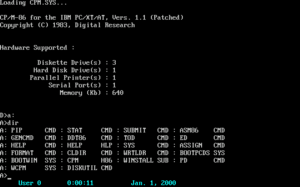 A screenshot of CP/M-86 | |
| Developer | Digital Research, Inc., Gary Kildall |
|---|---|
| Written in | PL/M, Assembly language |
| Working state | Historical |
| Source model | Originally closed source, now open source[1] |
| Initial release | 1974 |
| Latest release | 3.1 / 1983[2] |
| Available in | English |
| Update method | Re-installation |
| Package manager | None |
| Platforms | Intel 8080, Intel 8085, Zilog Z80, Zilog Z8000, Intel 8086, Motorola 68000 |
| Kernel type | Monolithic kernel |
| Influenced by | RT-11, OS/8 |
| Default user interface | Command-line interface (CCP.COM) |
| License | Originally proprietary, now BSD-like |
| Succeeded by | MP/M, CP/M-86 |
| Official website | Digital Research CP/M page |
CP/M,[3] originally standing for Control Program/Monitor[4] and later Control Program for Microcomputers,[5][6][7] is a mass-market operating system created in 1974 for Intel 8080/85-based microcomputers by Gary Kildall of Digital Research, Inc. CP/M is a disk operating system[8] and its purpose is to organize files on a magnetic storage medium, and to load and run programs stored on a disk. Initially confined to single-tasking on 8-bit processors and no more than 64 kilobytes of memory, later versions of CP/M added multi-user variations and were migrated to 16-bit processors.
The combination of CP/M and S-100 bus computers became an early standard in the microcomputer industry. This computer platform was widely used in business through the late 1970s and into the mid-1980s.[9] CP/M increased the market size for both hardware and software by greatly reducing the amount of programming required to port an application to a new manufacturer's computer.[10][11] An important driver of software innovation was the advent of (comparatively) low-cost microcomputers running CP/M, as independent programmers and hackers bought them and shared their creations in user groups.[12] CP/M was eventually displaced by DOS following the 1981 introduction of the IBM PC.
- ^ Cite error: The named reference
Gasperson_2001_Collectionwas invoked but never defined (see the help page). - ^ Cite error: The named reference
Mann83was invoked but never defined (see the help page). - ^ Cite error: The named reference
CPM.NYT83was invoked but never defined (see the help page). - ^ Cite error: The named reference
Kildall.NYTwas invoked but never defined (see the help page). - ^ Cite error: The named reference
Shustek_2016was invoked but never defined (see the help page). - ^ Cite error: The named reference
Kildall_1993was invoked but never defined (see the help page). - ^ Cite error: The named reference
Newton_2000was invoked but never defined (see the help page). - ^ Cite error: The named reference
byte1983_07was invoked but never defined (see the help page). - ^ Cite error: The named reference
Compupro816was invoked but never defined (see the help page). - ^ Cite error: The named reference
InfoWorld May 1981was invoked but never defined (see the help page). - ^ Cite error: The named reference
InfoWorld July 1982was invoked but never defined (see the help page). - ^ Cite error: The named reference
Commodore_128was invoked but never defined (see the help page).